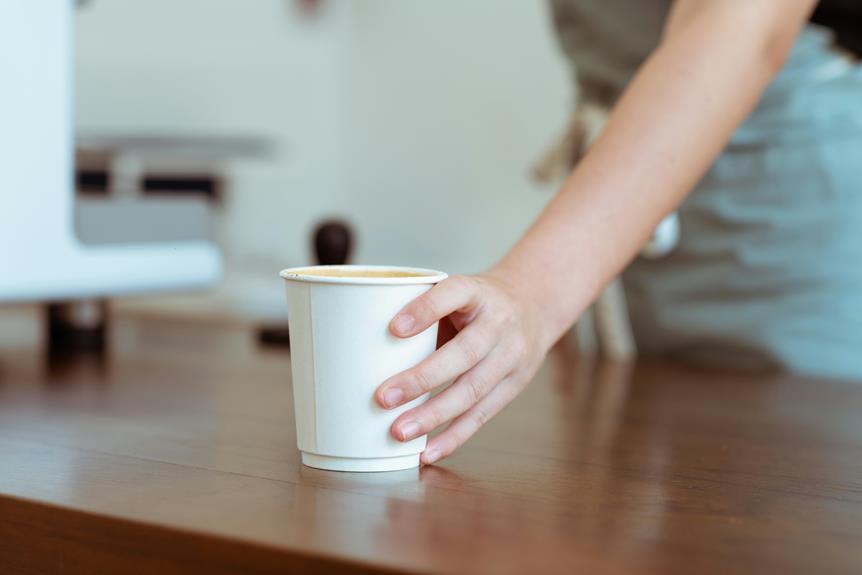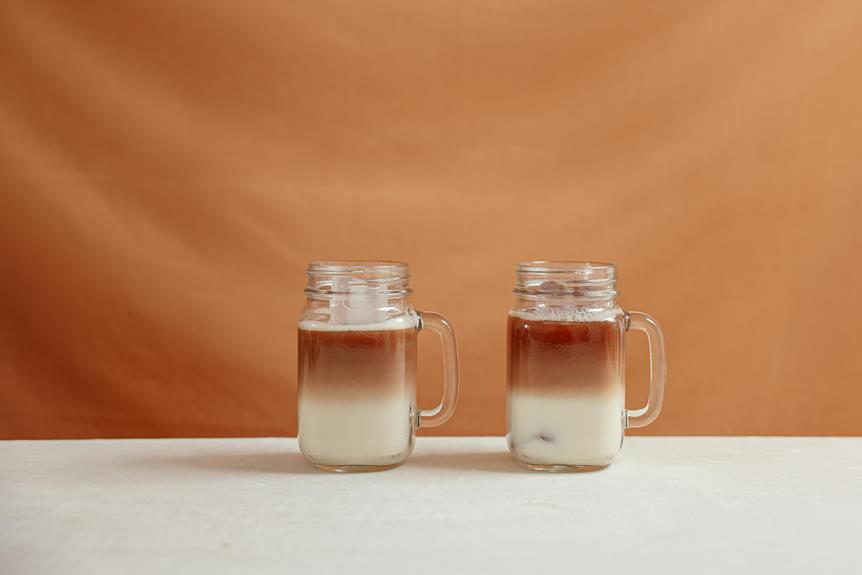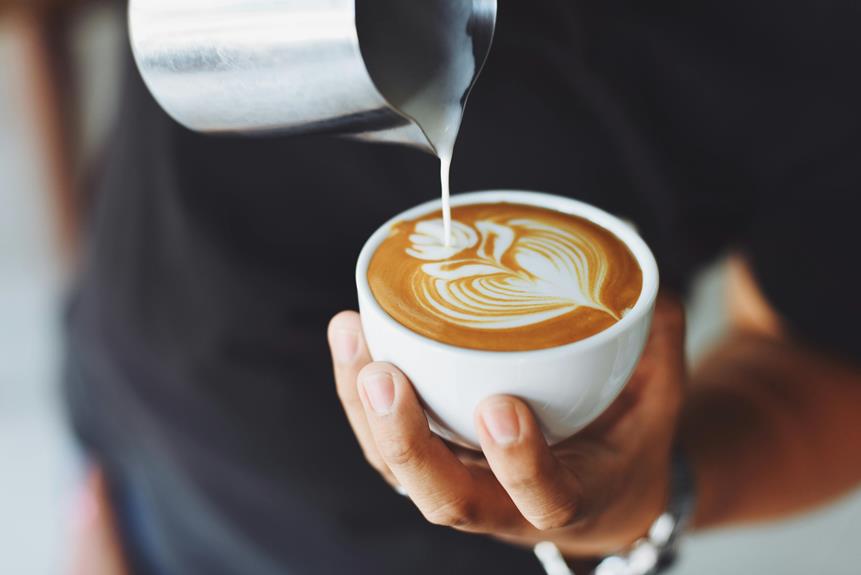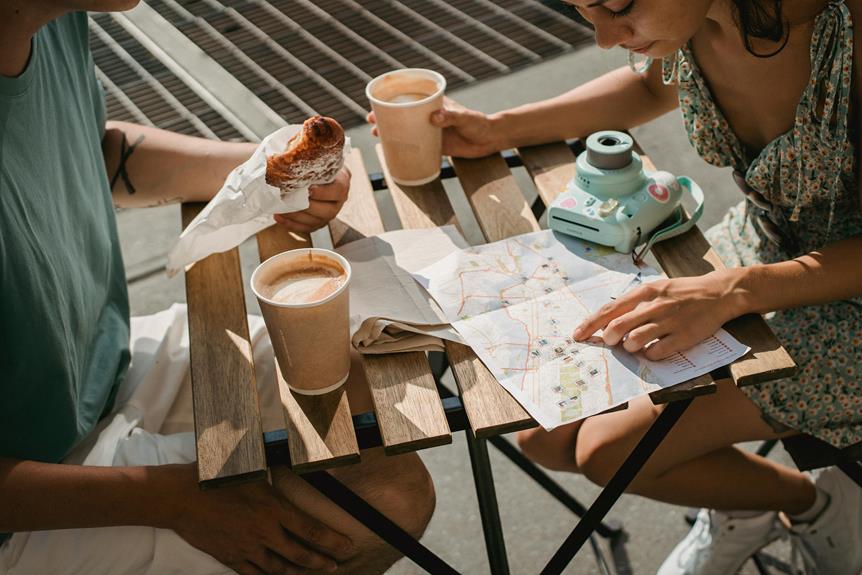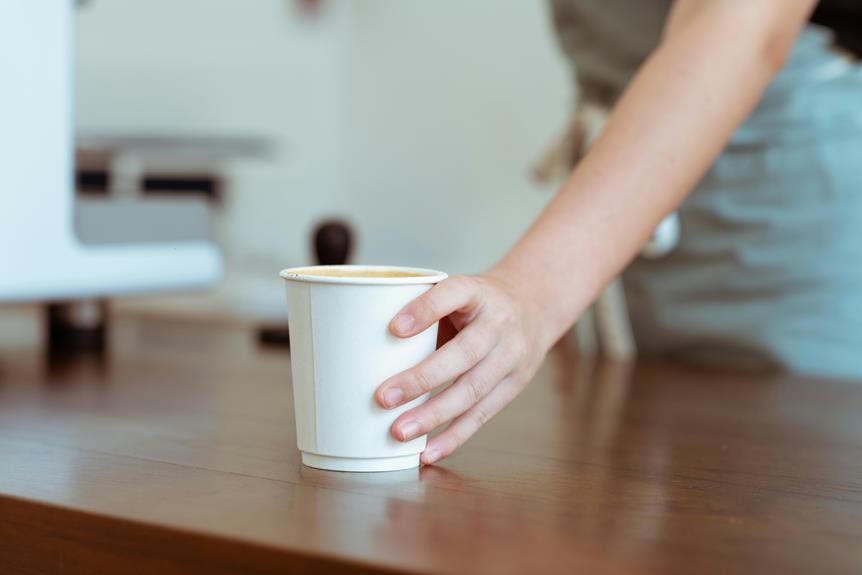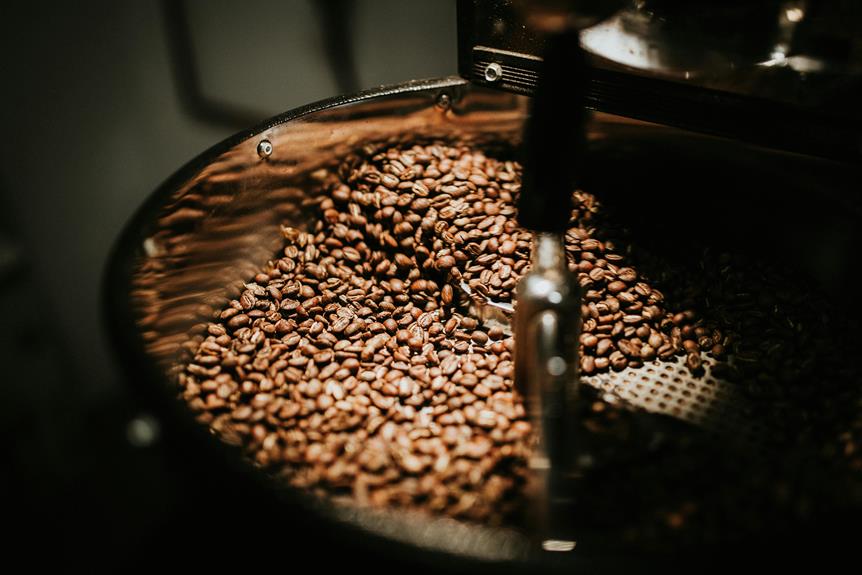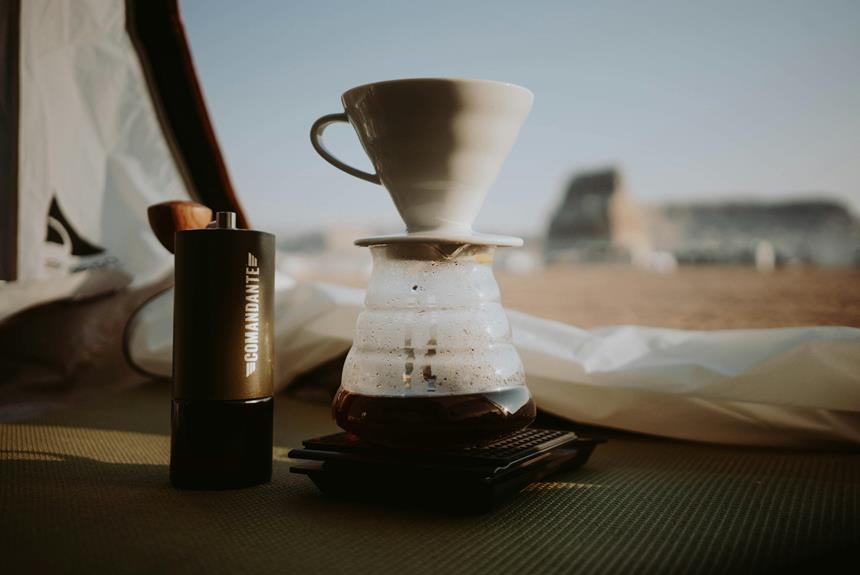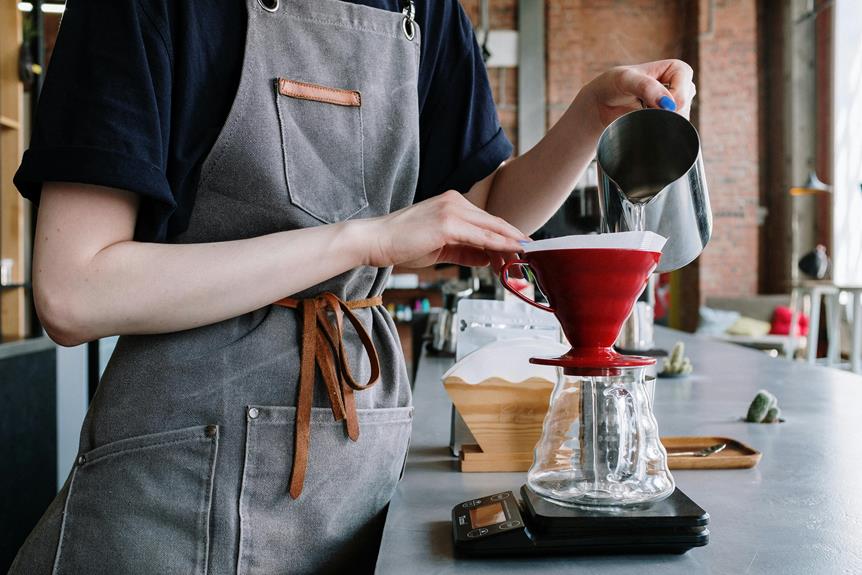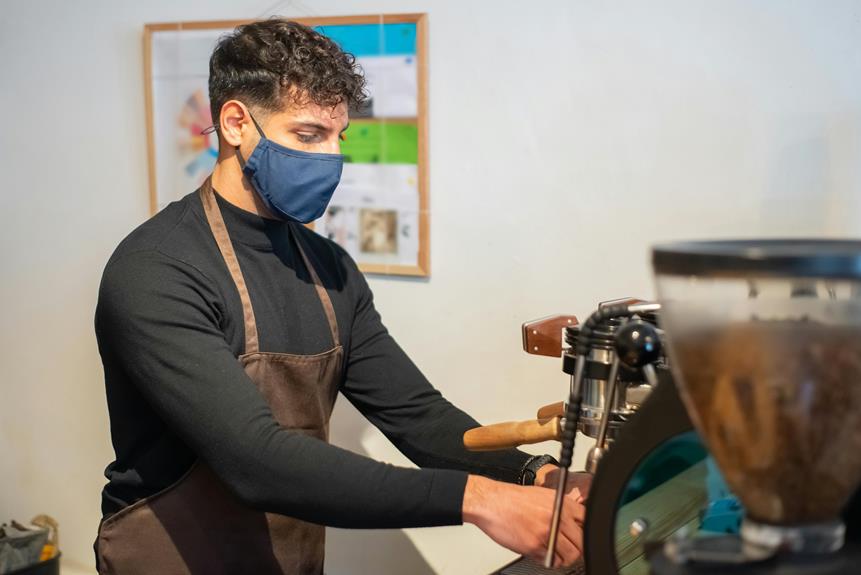You're about to tap into your inner barista and craft a delicious mocha that will impress even the most discerning coffee connoisseurs. Start with high-quality coffee beans, selecting a region that suits your taste profile. Grind them just before brewing to release the full flavor potential. Brew the perfect shot, aiming for a water temperature between 195°F and 205°F. Choose your milk, heat it to the ideal temperature, and froth it to a silky microfoam. Now, it's time to add chocolatey goodness – will you use cocoa nibs, chocolate chips, or syrup? As you combine the ingredients, balance the flavors and textures to create a harmonious experience. And that's just the beginning – there's more to master on your mocha-making journey.
Key Takeaways
- Use high-quality coffee beans, freshly ground just before brewing, to release full flavor potential and aromatic oils.
- Adjust grind size and brewing parameters to suit the coffee beans and brewing method for a perfect shot of espresso.
- Select and prepare milk that complements the coffee flavor, heating it to the ideal temperature and frothing it to a silky microfoam.
- Balance the flavors and textures of the mocha by combining the perfect shot of espresso with a generous helping of chocolate mixture and whipped cream.
- Pay attention to ingredient temperatures, whipping cream just until stiff peaks form, and using high-quality chocolate to create a delicious and visually appealing mocha.
Choosing the Perfect Coffee Beans
When it comes to crafting the perfect mocha, selecting the right coffee beans is essential, as they lay the foundation for a rich, velvety flavor that complements the chocolatey notes.
You'll want to choose beans from renowned coffee regions, such as Ethiopia, Brazil, or Colombia, which offer distinct flavor profiles. Ethiopian beans, for instance, provide a fruity and floral taste, while Brazilian beans offer a mild, nutty flavor.
Once you've selected your beans, it's vital to store them properly to preserve their flavor and aroma. You should store them in an airtight container, away from direct sunlight and moisture.
Avoid storing beans in the fridge or freezer, as the moisture can cause them to lose their flavor. Instead, keep them in a cool, dry place, like a pantry or cupboard.
Grinding for Optimal Flavor
Freshly grinding your coffee beans releases the full potential of their flavor, releasing a burst of aromatic oils that will elevate your mocha to new heights.
When you grind your beans just before brewing, you guarantee that the flavors and aromas are preserved, resulting in a more complex and nuanced taste experience.
To get the most out of your grind, remember:
Freshness matters: Grind your beans immediately before brewing to prevent staling and loss of flavor.
Consistency counts: Adjust the grind size to suit your brewing method, and experiment to find the perfect grind for your taste.
Invest in a good grinder: Blade grinders can generate heat, which can damage your beans, while burr grinders produce a consistent grind and preserve the flavor.
Experiment with ratios: Find the perfect balance of coffee to water to bring out the ideal flavor in your mocha.
Brewing the Ideal Coffee Shot
You're now ready to brew the ideal coffee shot, extracting the perfect amount of flavor and crema from your expertly ground beans.
To achieve this, understanding the perfect brewing parameters for your specific coffee beans is crucial. Coffee Roasters often provide guidelines for brewing their unique flavor profiles, so be sure to check their recommendations.
Generally, aim for a water temperature between 195°F and 205°F, and a brewing time of around 20-30 seconds. Adjust the grind size and tamping pressure to achieve the ideal flow rate.
As you brew, pay attention to the flow of coffee into your cup. It should be smooth and even, with a thick, velvety crema forming on top. If your shot is too fast or too slow, adjust your grind size and try again.
With practice, you'll develop a sense of what works best for your specific beans and brewing setup. By dialing in the perfect shot, you'll reveal the full flavor potential of your coffee and create a truly exceptional mocha.
Selecting Rich and Creamy Milk
With your ideal coffee shot in hand, it's time to complement its rich flavors with a velvety milk that's just as decadent.
Choosing the right milk is essential, as it can elevate or detract from your mocha's overall flavor profile. You'll want to select a milk that not only adds creaminess but also enhances the coffee's natural flavors.
When selecting a milk, consider the following options:
- Whole Milk: Rich and creamy, whole milk is a classic choice that pairs well with bold coffee flavors.
- Half-and-Half: A mixture of milk and cream, half-and-half adds a luxurious texture and subtle sweetness.
- Almond Milk: A popular dairy-free alternative, almond milk is light and nutty, making it ideal for those with dietary restrictions.
- Oat Milk: Creamy and velvety, oat milk is a plant-based option that's gaining popularity for its smooth flavor profile.
Heating and Frothing Milk
Heating milk to the perfect temperature and frothing it to a silky microfoam are essential steps in crafting a velvety-textured mocha that's sure to delight.
You'll want to heat your milk to around 140°F to 150°F (60°C to 65°C) for ideal flavor and texture. Anything hotter, and you risk scalding the milk, which can lead to a bitter taste.
When it comes to frothing techniques, you have a few options.
You can use a steam wand on an espresso machine to froth your milk to a silky microfoam. Alternatively, you can use a milk frother or a whisk to create a more rustic, bubbly texture.
Regardless of the method, the key is to incorporate air into the milk while heating it, which will give your mocha a light and creamy texture. Aim for a microfoam that's smooth and even, with a consistency similar to whipped cream.
Crafting Silky-Smooth Whipped Cream
Taking your mocha to the next level requires crafting silky-smooth whipped cream that's the perfect complement to your velvety-textured drink. You're about to create Whipped Wonders that will elevate your mocha game! To achieve this, you'll need heavy cream, sugar, and a pinch of patience.
Chill your bowl and beaters: Cold equipment is essential for incorporating air and creating a smooth, creamy texture.
Don't overbeat: Stop whipping once stiff peaks form. Overbeating will lead to butter and a grainy texture.
Add sugar gradually: Whip in sugar a tablespoon at a time, allowing each addition to dissolve before adding more.
Experiment with flavor: Try adding a teaspoon of vanilla extract or a pinch of cinnamon to create unique Creamy Concoctions.
Balancing Flavors and Textures
You'll need to balance the richness of your mocha with the sweetness of your whipped cream and the textures of the coffee, chocolate, and cream to create a harmonious flavor experience.
This is where flavor profiling comes in. Think about the flavor notes you want to highlight and the ones you want to balance out. Do you want a bold, rich coffee flavor or a subtle, smooth one? Do you prefer a sweet and creamy whipped cream or a light and airy one?
By considering these questions, you can create a flavor profile that works in harmony with the textures of your mocha.
Texture contrast is also essential in creating a delightful mocha experience.
You want to balance the smoothness of the whipped cream with the roughness of the chocolate shavings or the crunch of the coffee beans. The velvety texture of the mocha should complement the lightness of the whipped cream.
By balancing flavors and textures, you'll create a mocha that's not only delicious but also engaging and fun to drink.
Adding Chocolatey Goodness
With a solid flavor profile and texture contrast in place, it's time to introduce the star of the show: rich, decadent chocolate. You're probably wondering how to incorporate this indulgent ingredient into your mocha. The good news is that you have several options to choose from, depending on your personal taste preferences.
Cocoa Nibs: These tiny chocolate morsels add a deep, intense flavor and a satisfying crunch to your drink. Simply sprinkle them on top of your whipped cream or mix them into your coffee grounds before brewing.
Chocolate Chips: Melted or grated, chocolate chips can add a velvety smoothness to your mocha. Try using dark, milk, or white chocolate for different flavor profiles.
Chocolate Syrup: For a quick and easy addition, try drizzling chocolate syrup into your mocha. You can make your own or use store-bought.
Mocha Powder: Some coffee beans are infused with chocolate flavors, giving your mocha a rich, chocolatey taste from the get-go.
Now that you've added the perfect amount of chocolatey goodness, you're one step closer to creating the ultimate mocha experience.
Assembling the Perfect Mocha
Building the ultimate mocha requires precision, so start by pouring the perfect shot of espresso into a warmed cup.
This is the foundation of your mocha, and getting this step right is crucial. Next, add a generous helping of your chocolate mixture, carefully holding back the whipped cream for now.
As you combine the espresso and chocolate, pay attention to the flavor profile you're creating. You want a balance of rich, bold espresso and deep, velvety chocolate.
Now it's time to add the finishing touches.
Hold the cup at an angle and gently pour the whipped cream on top, creating a smooth, rounded peak.
This is where your mocha artistry comes in – use a spatula or spoon to create a design that's both beautiful and Instagram-worthy.
Finally, add a sprinkle of chocolate shavings or cocoa powder to complete the look.
Stand back and admire your handiwork – you've just assembled the perfect mocha!
Tips and Tricks for Perfection
To take your mocha game to the next level, pay attention to the temperature of your ingredients, as lukewarm espresso or chocolate can throw off the entire flavor profile. You want your espresso to be hot, but not scalding, and your chocolate to be melted to perfection.
Don't over-whip the cream: Whip it just until it forms stiff peaks, then stop. Over-whipping can make it too stiff and separate.
Use high-quality chocolate: Don't skimp on the chocolate – use a high-quality brand for the best flavor.
Experiment with spices: Add a pinch of cinnamon, nutmeg, or cayenne pepper to give your mocha a unique twist.
Pay attention to ratios: Find your perfect balance of espresso to chocolate to cream – and stick to it.
Frequently Asked Questions
Can I Use Decaf Coffee Beans for a Mocha?
You can definitely use decaf coffee beans, but keep in mind they might lack the rich flavor you're used to. Look for high-quality decaf beans to guarantee a smooth, full-bodied taste that won't compromise on flavor.
How Long Does Homemade Whipped Cream Last in the Fridge?
You'll be thrilled to know that your Whipped Wonders can last up to a week in the fridge, but beware of Freshness Factors like contamination and temperature fluctuations that can shorten their shelf life.
Are There Dairy-Free Milk Alternatives for Mochas?
"You're probably thinking, 'Dairy-free milk alternatives? How boring!' But trust us, you won't miss the dairy with almond benefits like healthy fats and Soy options that are just as creamy – perfect for a delicious mocha!"
Can I Make a Mocha With Cold Brew Coffee?
You can definitely make a mocha with cold brew coffee, and it's a game-changer! Cold brew benefits include a smoother, less acidic flavor, which allows the rich flavor profiles of chocolate and milk to shine through beautifully.
How Do I Clean My Steam Wand After Frothing Milk?
"Oh, you've finally decided to clean your steam wand, huh? About time, considering the milk-curdling bacteria party it's been hosting. Follow Wand Maintenance 101: purge, soak, and wipe down your wand for Frothing Tips that'll make baristas proud!"
Conclusion
Now that you've mastered the art of crafting the perfect mocha, the question is: what's holding you back from becoming a mocha aficionado?
With these simple steps, you've discovered the secrets to a rich, velvety, and utterly divine drink.
Go ahead, experiment with flavors, and push the boundaries of mocha madness!
Your taste buds (and your friends) will thank you.
